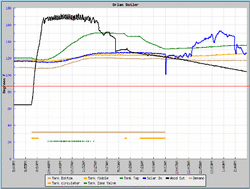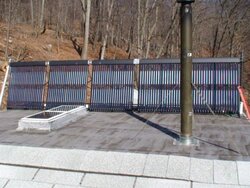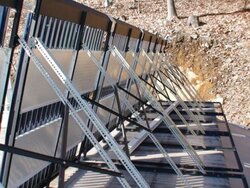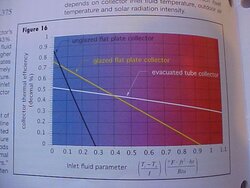ISeeDeadBTUs said:
Joe. . . . I have 16" seams, what sort of mounting hardware is available?
Depends on your roof pitch. This was a 6/12 pitch. For summer performance, you want the panels to match your latitude. For winter performance, check a solar chart. In this case, we wanted to enhance winter performance, to provide a small amount of backup space heating as well as to avoid overheating the tank in the summer, so we decided on an angle around 60 degrees. To mount the panels, we used a flat roof frame (similar to what's shown in the pictures in this thread) to bring the panels up at a steeper angle than the roof.
ISeeDeadBTUs said:
How much wind can it withstand?
I've never heard of a problem with wind. The evacuated tubes let a lot of the wind flow right through. For actual wind performance numbers, I'd contact the manufacturer.
To mount the "feet" of the frame, we used lag bolts into the strapping under the metal roof, which held everything nice and steady, then we drilled through the roof and used stainless bolts with nuts and fender washers inside the attic.
ISeeDeadBTUs said:
Does anyone make a mounting system that would reposition the panel as the sun progresses throughout the day?
Theoretically, you could use one of those trackers that they make for PV panels, and use the flexible piping to allow it to move the panel around, but you might fatigue the piping.
But there really wouldn't be much benefit, with the efficiency of the evacuated tubes. They pull in a lot of solar energy, and you can turn each individual tube during installation so that it points due south, even if the roof isn't exactly dead-on south-facing. I don't think there would be a benefit to tracking. I've seen systems where the roof ridge was north-south, where they put a panel on each roof, and use a controller to just switch panels as the sun moved. If you had a roof facing east, one facing south, and one facing west, I suppose you could cycle through the panels as they heated up, and avoid the maintenance issue of a tracker and flexible piping getting continuously flexed. In the long run, that would probably be cheaper than maintaining a tracker.
Now, being able to vary the pitch of the panels between summer and winter would be a benefit. I think I'll be doing that when I put mine in either this summer or next. I'll manufacture my own frame with hinges and such to allow for that, and have a few "stops" in the adjustment, so I can move it a few times during the year as the sun's angle changes. During the summer, the panels will be just barely steeper than my 12/12 roof (since the latitude is roughly 43* here), and during the winter they will be able to go all the way up to 70* or so. I'll probably just have it work with a hand-crank, since I can walk out onto the roof from one of my windows. Remove the pins, crank it up or down, and they re-install the pins at the new angle.
Joe





 ):
):